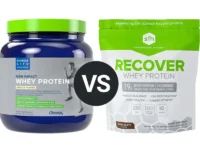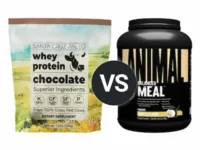Knowledge BaseYou're Questions Answered
How do I know if a protein powder contains artificial ingredients?
To determine if a protein powder contains artificial ingredients, it's important to read the label and ingredient list carefully. Manufacturers are required to list all ingredients on the label in descending order by weight, so the first few ingredients listed will be the most abundant in the product. Here are some tips for identifying artificial ingredients in protein powder:
- Look for common artificial sweeteners: Many protein powders contain artificial sweeteners, which are added to improve taste without adding calories. Some common artificial sweeteners include aspartame, sucralose, and saccharin. These will be listed in the ingredient list by their specific name.
- Check for preservatives and additives: Many protein powders also contain preservatives and other additives, which are used to improve texture, increase shelf life, and enhance flavor. Look for ingredients like sodium benzoate, potassium sorbate, and hydroxypropyl methylcellulose.
- Look for natural flavors and sweeteners: If a protein powder uses natural ingredients, the label will usually indicate this prominently. Look for terms like "natural flavor" or "naturally sweetened with stevia" to indicate that the product does not contain artificial ingredients.
- Research the manufacturer: Do some research on the manufacturer of the protein powder to see if they have a reputation for using natural or artificial ingredients. Check the manufacturer's website for information on their ingredient sourcing and quality control practices.
It's important to note that not all artificial ingredients are harmful, and some are generally recognized as safe by regulatory agencies like the FDA. However, some people may prefer to avoid artificial ingredients for personal or health reasons. If you have specific concerns about the ingredients in a protein powder, consult with a healthcare professional or a registered dietitian.
- US Food and Drug Administration. Guidance for Industry: Food Labeling Guide.
- Blundell JE, Hill AJ. Artificial sweeteners and obesity. In: Preedy VR, Watson RR, Martin CR, eds. Handbook of Behavior, Food and Nutrition. Springer New York; 2011:1667-1684.
- European Food Safety Authority. Safety of artificial sweeteners. EFSA J. 2011;9(6):2229.
Your Answer
We are a participant in the Amazon Services LLC Associates Program, an affiliate advertising program designed to provide a means for us to earn fees by linking to Amazon.com and affiliated sites.


